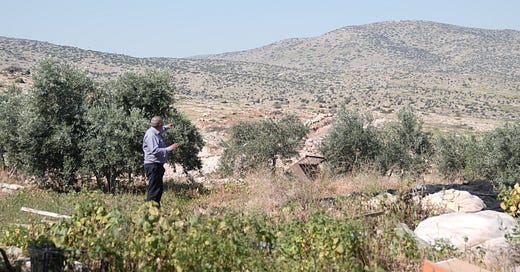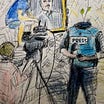Israeli Policies and Settler Violence Are Driving Palestinians from the Jordan Valley
In the occupied West Bank, Israeli restrictions on movement for Palestinians, denial of access to resources, and settlement expansion have all ramped up over the past 18 months.

Story by Issam Ahmed
JORDAN VALLEY, OCCUPIED WEST BANK—Yousef Bsharat stood outside his home made up of corrugated metal sheets and tent fabric in the village of Khirbet Makhoul nestled in the northern Jordan Valley. Vast stretches of land—where his sheep can no longer graze—extended to the horizon in front of him. At 63 years old, Bsharat has known no home but this village and has lived through decades of Israel’s ever-tightening grip in the occupied West Bank. Still, he said his situation has never been as grim, nor his future as uncertain, as it is now.
"We live in constant anxiety, day and night, due to settler attacks," Bsharat told Drop Site. His family of 12 relies primarily on their flock of sheep for a living. In recent months, they have been repeatedly threatened by Israeli settlers, who warn they will be shot if they cross onto the nearby land. "They raid our communities with tractors, provoke residents, and prevent us from accessing grazing areas. The army and settlers have seized the land for settler cattle farms."
As Israeli enclosures and restrictions on movement have cut him off from more and more grazing land, he has had to slaughter 120 of his once-thriving herd of 600 sheep over the past three months alone. He is struggling to afford fodder to feed the rest. Despite being surrounded by lush pastures, rich with natural resources, Bsharat has found it difficult to source water for his flock.
Bsharat’s growing hardship is shared by many shepherding communities in the Jordan Valley, which is home to some 60,000 Palestinians. This fertile, strategically important stretch of land makes up nearly a third of the West Bank and was designated as “Area C” under the Oslo Accords in the 1990s—meaning it remained under full Israeli control with a commitment to gradually transfer it to Palestinian jurisdiction, although that handover never happened.
Instead, Israel has spent decades consolidating its hold on the land by imposing policies that drive Palestinian families, who have lived there for generations, off of it. Through a combination of tactics deployed across the occupied West Bank—including bureaucratic restrictions, denial of access to resources, and settlement expansion—Israel has worked to redraw the geographic and demographic makeup of the Jordan Valley by making living conditions nearly impossible for Palestinian residents.
Since October 7, 2023, these policies have all ramped up. While the world’s attention has focused on Israel's genocidal assault on Gaza and, to a lesser extent, on the military campaign in West Bank towns like Jenin and Tulkarem—where entire refugee camps have been destroyed and tens of thousands of Palestinians displaced—the increasingly harsh plight of communities in the Jordan Valley has largely gone unnoticed.
Ayman Gharib, an anti-settlement activist and Jordan Valley resident, said a new Israeli outpost “pops up every day.”
“What began as three settlement outposts years ago has recently mushroomed into dozens, with new outposts appearing almost daily, and existing ones expanding their boundaries,” he added.
As outposts grow in number and expand, Palestinian communities in the Jordan Valley are being turned into isolated islands. They are surrounded by land which neither they nor their livestock can access—stranded without basic utilities, and subject to settler harassment and violence.
"The suffering of residents isn't measured by the number of outposts, but by the areas controlled by these outposts, individual settlers, or cattle-ranching settlers," Gharib said. Entire communities have been forced to leave their homes and land as a result.
Over the past 18 months alone, Gharib has documented the displacement of 30 families from various Jordan Valley areas. "In Um al-Jamal community, residents of 14 families—no less than 120 people—have fled and settlers have begun establishing agricultural roads and facilities In Fao area, all residents were displaced. In Al-Saidaa, a vast area, settlers have taken control,” he said, adding that two new outposts were established in February, along with their accompanying roads and walls that have further isolated Palestinian herders nearby.
Living under siege
In the village of Bardala, at the northeastern edge of the West Bank, the dwindling number of remaining residents face increasing restrictions on their movement. Walls, barriers, and other enclosures have encircled their community. In February, Israeli authorities dug long trenches—a barrier that Palestinian residents are now prevented from crossing.
“The recently constructed walls have cut 8,000 sheep from reaching approximately 22,000 dunams (5,440 acres) of grazing land and prevented farmers from cultivating about 1,500 dunams (370 acres) that once produced field crops and vegetables,” Ibrahim Sawafta, the head of the Joint Services Council in the northern Jordan Valley, told Drop Site.
In Al-Fareseya village, where several families remain, settlers have provocatively raised the Israeli flag on installations erected close to Palestinian homes. “In Bardala, a single settler established a pastoral outpost, preventing several residents from accessing their land, while he grazes his cows on the residents' crops,” said Gharib. Intensified harassment and threats have forced five families out of Bardala since October 7, 2023, he added, noting that some 2,700 people continue to hold onto their homes and lands despite worsening conditions.
"There were 16 families living in Maqhoul. Today, there are only four of us left," Bsharat says. For those who remain, economic pressures continue to mount. "After closing the grazing areas, we've had to depend on fodder, which is expensive and causes significant losses," he said. "I now have to buy about 180 tons of fodder for my flock, whereas previously I only needed to purchase about 60 tons."
Water as a weapon
In Bardala, access to water represents another facet of control. Nasser Jamil, 55, owns about 60 dunams (15 acres) of farmland where he works with his family growing cucumbers and zucchini. "Water arrives only once every three days," Jamil said. "I need to water and fertilize my cucumbers, but there's no water, which means crop failure."
Jamil built a small reservoir to collect groundwater, but he said Israeli authorities recently issued demolition orders against it, claiming it was built without permits.
"I spend the entire day monitoring irrigation due to insufficient water," he said. "I live in fear of having to abandon the land if water is cut off completely. We live without stability, without water. The occupation wants us to leave our land, but we will remain for as long as we can."
From his land, Jamil can see water pipelines serving nearby Israeli settlements, while his own farm is parched. "My family once had an artesian well that was dried up by the occupation decades ago, and they won't allow us to reactivate it," he said.

Israeli restrictions on Palestinians’ access to water is a decades-old practice. A 2012 report by the organization EWASH found that Palestinians are forced to buy 52% of their water supplies from Mekorot, the Israeli National Water Carrier, because they are largely denied access to local groundwater resources.
According to the report, Israel’s policies and practices restrict Palestinians’ average daily per capita water consumption rate to between 50 and 70 liters, compared to around 300 liters for Israelis. In some areas of the West Bank, such as the Jordan Valley, the gap is even wider.
Sawafta, the head of the Joint Services Council in the northern Jordan Valley, said that Bardala is located above the second-largest aquifer in the West Bank, and that for decades, Israel has intentionally dried up wells on which local communities have relied.
"After an agreement with the Israeli Mekorot company in 1971, they were supposed to provide Bardala, Kardala, and Ein al-Baida villages with 250 cubic meters," Sawafta said. "But Israel drilled another well producing about 2,700 cubic meters daily. Today, the three villages with 6,000 residents and 10,000 sheep get only 500 cubic meters, while four small settlements receive all the rest."
Military zones and displacement
According to Amir Daoud, director general of publication and documentation at the Wall and Settlement Resistance Commission (WSRC), Israeli authorities’ approach to creating a "coercive environment forcing residents to leave" in the West Bank has intensified over the past two years. In July, the Israeli government approved the single largest seizure of land in the West Bank since the Oslo Accords three decades ago.
"Israel is on a mission to besiege the Palestinian presence and natural growth in the Jordan Valley to completely eliminate Palestinian existence," Daoud said.
Since October 7, 2023, the WSRC has documented the forced displacement of 29 communities, comprising more than 310 bedouin families—over 1,707 people—from various parts of the Jordan Valley.
Israel classifies about 235,000 dunams (58,000 acres) of northern Jordan Valley land as closed military training zones, representing 7.5 percent of all closed training areas in the occupied Palestinian territories.
"Ninety percent of Jordan Valley lands are under Israeli control," Daoud said. "The army imposes restrictions while settlers launch rampages and attacks in a functional exchange.”
According to data from the WSRC, the northern Jordan Valley now has 14 Israeli settlements and 17 outposts inhabited by approximately 3,000 settlers, while Israel maintains over 40 checkpoints in the area.
"After October 7, 2023, the occupation and settlement activities have become more aggressive in all aspects of life, including education and health. Checkpoints are closed, preventing Palestinian movement," Sawafta notes.
Despite these mounting pressures, residents like Jamil remain defiant: "This is my land and my water. They've taken control of it. But we have no choice but to stay."
This piece was published in collaboration with Egab.






you see this happening over and over again. "No other land" is basically about this, free palestine tv just dropped an interview with a lonely farmer as well, whose property is staked with Israeli flags and they just flatout tell him, if he touches the flags they'll cut off his hands.
I hate the word "settler" used by Zionist land thieves. It seems to be a word used for Zionist propaganda to make obvious terrorism sound nice to the Wests MSN.
Thank you Drop Site for exposing the lies of the Zionist Israeli parasites.